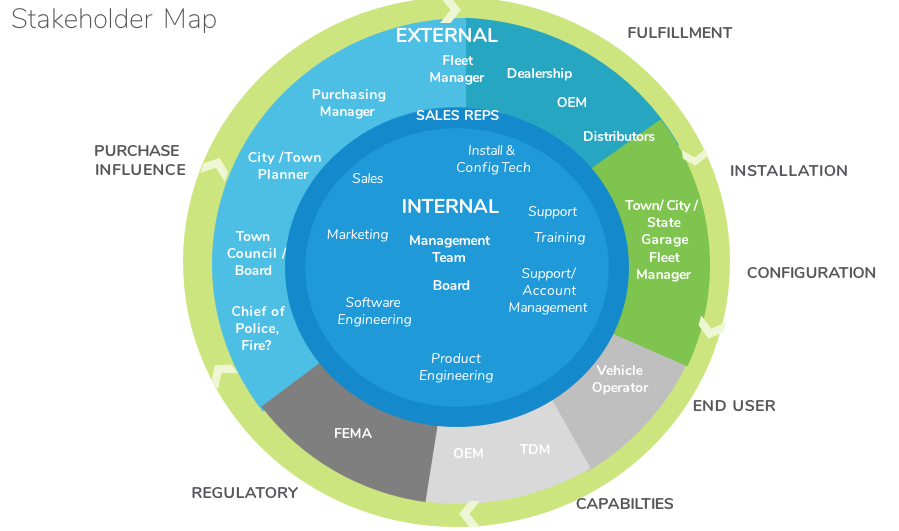
Before we get into an understanding of how to do stakeholder mapping…
Let’s first have a look at what we mean by the term stakeholder mapping.
Definition 1:
Stakeholder mapping is the process of identifying and categorizing key stakeholders involved in achieving the policy objectives of your organization.
Mapping helps you evaluate your relationships with stakeholders so you can organize communication strategies and engagement efforts depending on where someone falls within your stakeholder mapping.
Stakeholder mapping is a critical aspect of stakeholder engagement.
Definition 2:
A simple definition of stakeholder mapping is the process of drawing a visual representation of the various people involved in or affected by the project.
This visual tool should provide a clear picture of who the various stakeholder groups are, as well as their motives and interests.
We have a great article on understanding what your client or prospect really wants by using active listening skills here
Stakeholder maps are designed to facilitate the evaluation of your environment by highlighting what powers are at play to help or hinder the progress of your project.

Image Source: The Design Thinking Salon
If you were to do your own internet research into the subject you will find that much of the content on stakeholder mapping (like those above) relates to project management, and the successful delivery of projects from start to finish.
In this case a project might be the building of a new office block or school, bringing a new product to market, or mapping out a political campaign. The use cases are endless.
However, you may not come across the use of the words “stakeholder mapping” and “sales” in the same sentence very often. And yet, stakeholder mapping can be critical to the success of a sales campaign, particularly when the deal size is larger or of a critical nature to yourself or the prospect or client…
Stakeholder mapping in a sales context
If the saying that “people buy from those that they know, like and trust” holds true, then it stands to reason those successful salespeople will be the ones that have high sales led emotional intelligence (sales EQ) and an ability to connect and engage with their prospects and clients in a way that leads to the desired outcome for both parties.
Often, particularly for more complex solutions, you will not be dealing with just one decision maker – the someone that has a stake in the success of the decision to buy.
So, what happens if you don’t understand who the stakeholders are for a more complex sales scenario? Who are the influencers? The decision makers? (if there’s more than one of them). And have you connected and engaged them at the right times?
That’s where stakeholder mapping comes in.
Let’s say that you are Bill, a salesman working for ACME IT Solutions, a large provider of Information Technology (IT) applications, infrastructure, and services.
You have been working with a prospect in the finance industry for several months and through careful research and needs analysis have realised that you could reduce their IT budget, saving them $USD millions in the process, whilst significantly improving their operational efficiency and the level of customer service within their business.
However, to deliver these benefits you would need them to outsource the IT department to your company. You take the idea to your Sales Director, Corrina, and she likes the concept in principle.
She then asks you who the stakeholders are in such a venture… What do you say?
Naturally, as a top performer, you preempted this question and had already built a straw man (effectively a model or outline of the opportunity and the sales campaign) that includes information such as:
- The key players in such a decision as well as the critical business issues that they face
- A profile of the prospect including their market and company including financial analysis
- An outline of the opportunity including outcomes, deal size, short-and long-term revenue and profit opportunity for ACME IT Solutions
- The needs of the business and the value that ACME IT Solutions will be providing
- The product or service capabilities that you would be providing aligned to each key player
- Case studies and references that you can leverage
- The potential business model
- An outline of the sales campaign and the steps needed
As you present your outline, Corrina asks you again about the stakeholders, and the conversation goes something along the following lines:
Corrina: “Who would have a stake in the project?”
You: “Well, definitely the IT Director [Stakeholder], as it would be his department that we would be outsourcing.”
Corrina: “Who else?”
You: “The Board of Directors for the financial institution”
Corrina: “For example?”
You: “I guess the Chief Financial Officer [Stakeholder]. Maybe the Managing Director [Stakeholder]. I’m not sure if it would go as high as the Chairman.” You pause for a moment, thinking…
“I know the IT Director has three Heads of Department as direct reports. They would need to be involved [Stakeholders].”
Corrina: “OK. What about the HR Director?” [Stakeholder]
You: “Why would they need to be involved?”
Corrina: “Well, if they were to outsource their people to us, that will affect employment contracts, terms and conditions of employment, possibly pay scales, other benefits, employee morale and so on.”
You: “Ah, I hadn’t thought of that.”
Corrina: “What about their procurement department? Whom would be involved in purchasing?
Would they look at our competitors to make sure that our offer is a good one? What is the buying process they would follow? And who is the Head of Procurement?” [Stakeholder].
So far Corrina and Bill have identified several possible stakeholders in the project:

Now Corrina starts to go deeper with her questioning of Bill:
Corrina: “Which of these stakeholders have you met?”
You: “The IT Director, the Head of Infrastructure and the Head of Application Development, and the Head of Procurement”
Corrina: “Have you mentioned this idea to them?”
You: “Not yet. I wanted to discuss it with you first and get your input”
Corrina: “OK, good. Put a red flag against the HR Director, Head of Client Services, Chief Financial Officer and Managing Director, and green flags against those you have met.”
Corrina goes on to ask additional questions to deepen her understanding, such as:
Corrina: “Who would be your inside sponsor for the project, the one that would help push the decision through?
“How would you describe your relationship with them? Is it strong ‘+’ or weak ‘-‘?
“What are the business reasons why they should do this?
“What does each of the stakeholders we’ve identified have to gain or lose if they go ahead?
“Who would sign the deal off?”, and so on.
She then starts to ask about the politics within the organisation, and the relationship between the IT Director and his Heads of Department.
What Corrina is looking for is any factors that could work for or against the project. Who would be supporters and allies, and who might be dissenters?
As Bill and Corrina continue the discussion the stakeholder map started to build out and they identified gaps in their knowledge, whom they needed to approach and focus upon, and the questions to ask.
They added more detail to the chart, so that each stakeholder was visible
At this point you may have realised that the stakeholder map that they were building was about the prospect, so “outward” looking.
On a project of this nature, it is worth considering whether you should also do a stakeholder map for your own organisation – an “Internal” view.
The reason you might consider this is that you will need sign-off for the project internally. As well as sales leadership support, the project may need a significant level of financial due diligence.
Your own HR function will need to be involved as there are implications for your business in transferring employees from the prospect.
You might also consider the sales process. It is likely that you will need to engage the leadership team from ACME IT Solutions in peer-to-peer relationship mapping, for instance.
This is the subject of another blog…
If you would like to receive training on how to do stakeholder mapping, please schedule a complimentary consultation

Alan Bell
Want to receive more great sales strategies directly in your inbox? Complete the form to receive future content by email

Recent Comments